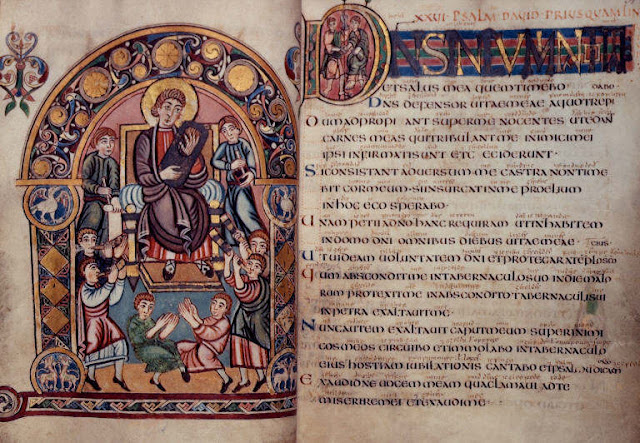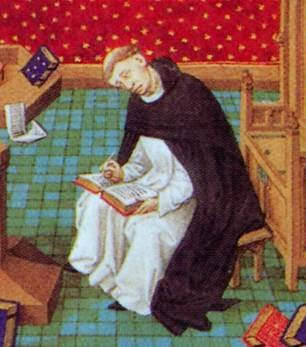Unknown artist
Christina von Stommeln, c. 1909High altar of the Propsteikirche Mariä Himmelfahrt Jülich
Museum Zitadelle Jülich
Unknown artist
Detail: Christina von Stommeln, c. 1909High altar of the Propsteikirche Mariä Himmelfahrt Jülich
Museum Zitadelle Jülich)
Christina von Stommeln was a Beguine who was ascribed mystical experiences, so that she gained the reputation of holiness and was worshiped in the area of the Duchy of Jülich and in the Archdiocese of Cologne.
Stommeln, called in the fourteenth century Stumbeln, is situated about nine miles northwest of Cologne and about six miles west of the Rhine.
Christ hands Christina a ring The embroidered figures on the silk gloves from the shrine of Blessed Christina von Stommeln are the oldest representations of Christina
Museum Zitadelle Jülich
Christine's father was a well-to-do peasant. When five years old Christine had visions of the Christ Child to whom she was mystically married in her tenth year. When eleven years old she learned to read the Psalter, but could not write.
Unknown Author
Vespasian PsalterOn the right is the beginning of Psalm 27
On the left in an image David with Jonathan,, c. between 725 and 750
London, British Library, Cotton Vespasian
A psalter is a volume containing the Book of Psalms, often with other devotional material bound in as well, such as a liturgical calendar and litany of the Saints. Until the emergence of the book of hours in the Late Middle Ages, psalters were the books most widely owned by wealthy lay persons.
Anthony Van Dyck
“Portrait of a Lady, Possibly a beguine”
Oil on canvas
17 ¼” x 12 ¾”, (43.8 x 32.4 cm)
Private collection
Sir Anthony van Dyck, ( 22 March 1599 – 9 December 1641) was a Flemish Baroque artist who became the leading court painter in England, after enjoying great success in Italy and Flanders. He is most famous for his portraits of Charles I of England and his family and court, painted with a relaxed elegance that was to be the dominant influence on English portrait-painting for the next 150 years. He also painted biblical and mythological subjects, displayed outstanding facility as a draughtsman, and was an important innovator in watercolour and etching. The Van Dyke beard is named after him. More Sir Anthony van Dyck
When twelve her parents wished to give her in marriage, but she went to the convent of the Beguines at Cologne, where she led a life of severe penance, spent much time in prayer, and often fell into convulsions.
Sister Plautilla NelliReceiving the Stigmata
Saint Catherine Receives the Stigmata
Last Supper Museum of Andrea del Sarto
Sister Plautilla Nelli (1524 – 1588) was a self-taught nun-artist and the first-known female Renaissance painter of Florence. She was a nun of the Dominican convent of St. Catherine of Siena located in Piazza San Marco, Florence, and was heavily influenced by the teachings of Savonarola and by the artwork of Fra Bartolomeo
Pulisena was born into a wealthy family in the San Felice area of Florence. There is a modern-day street in Florence, Via del Canto de’ Nelli, in the San Lorenzo district, named for her family.
She became a nun at the age of fourteen, taking on the name Suor Plautilla, at the convent of Santa Caterina di Cafaggio; she would later be prioress on three occasions. The facility was managed by the Dominican friars of San Marco. About half of all educated girls in that era were placed into convents to avoid the cost of raising a dowry. Savonarola's preachings promoted devotional painting and drawing by religious women to avoid sloth, thus the convent became a center for nun-artists.
Though she was self-taught, she copied works of the mannerist painter Agnolo Bronzino and high Renaissance painter Andrea del Sarto. Her primary source of inspiration came from copying works of Fra Bartolomeo. Nelli signed her paintings as "Pray for the Paintress" after her name, confirming her role in spite of her gender.
Her work is distinguished from that of her influencers by the heightened sentiment she added to each of her characters' expressions. Most of Nelli's works are large-scale, which was most uncommon for a woman to paint, in her era.
Her work is characterized by religious themes, with vivid portrayals of emotion on her characters' faces. Nelli lacked any formal training and her male figures are said to have “feminine characteristics”, as her religious vocation prohibited study of the nude male. More on Sister Plautilla Nelli
In her fifteenth year she received the stigmata on her hands and feet and the marks of the Crown of Thorns on the head. The wounds reappeared throughout her life each Easter Sunday.
Unknown artist
Christina of Stommeln defeating the devil
I have no further description, at this time
She suffered many assaults of the devil, had many trials of her faith and was tempted to suicide. The Beguines thought her crazy and treated her with contempt, so she went back home.
Unknown artist
Peter of Dacia, a Dominican from Gotland
I have no further description, at this time
As early as 1267 the parish priest, Johannes, took Christine into his house, where she made the acquaintance of Peter of Dacia, a Dominican from Gotland who was at Cologne as a pupil of St. Albert the Great.
A mystical bond of devotion, the object of which was God, was formed between the two. Peter visited Christine in 1270 on his way back from Paris to Gotland, and again in 1279; in his account of her he mentions altogether fifteen visits.
Unknown artist
Christina von Stommeln
I have no further description, at this time
Christine's brother followed Peter to Gotland and entered the Dominican Order. Peter became lector and in 1283 was prior in Gotland, where he died in 1288. In the same year the torments which Christine suffered through the devil ceased, and she lived a peaceful life, wearing always the dress of the Beguines, until her death.
Church of St. Mary of the Assumption in Jülich
Her body was first buried in the churchyard at Stommeln and then in the church itself; in 1342 her remains were carried to Niedeggen in the Eifel; a couple of centuries later, 22 June, 1569, they were transferred to Jülich, where a monument to her still exists. At Jülich are also to be seen the notes made by Peter of Dacia and the collection of her letters which the Bollandists have published under the date of 22 June (IV, 271-430).
Unknown artist
Christina von Stommeln
I have no further description, at this time
It is difficult to decide just how much literal truth exists in Christine's visions and apparitions from Purgatory. But even Renan did not doubt the purity of her life (Hist. litt. de la France, XXVII, 1-26). The veneration of the Church has not been granted to Christine; however, the anniversary of her death, 6 November, is observed in Jülich. More on Christina von Stommeln
Please visit my other blogs: Art
Collector, Mythology, Marine
Art, Portrait of a Lady, The
Orientalist, Art of the Nude and The
Canals of Venice, Middle
East Artists, and 365 Saints, also visit my Boards on Pinterest
Images are copyright of their respective owners, assignees or others.
Some Images may be subject to copyright
I don't own any of these images - credit is always given when due unless
it is unknown to me. if I post your images without your permission, please tell
me.
I do not sell art, art prints, framed posters or reproductions. Ads are
shown only to compensate the hosting expenses.
If you enjoyed this post, please share with friends and family.
Thank you for visiting my blog and also for liking its posts and pages.
Please note that the content of this post primarily consists of articles
available from Wikipedia or other free sources online.












No comments:
Post a Comment
Note: Only a member of this blog may post a comment.